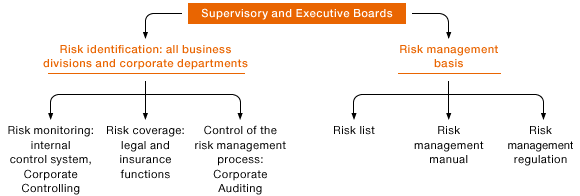Risk Management Structures and Tools
This groupwide system draws on existing organizational and reporting structures, supplemented by additional elements:
- The risk management manual: this contains the system’s principles and processes. It explains reportable levels of risks and how risks are to be covered and mapped.
- The risk management regulation: it stipulates groupwide reporting requirements, including when a specific committee must be informed.
- The risk management coordinator: this coordinator is responsible for the risk management system and is supported by local risk coordinators.
- The risk list: this records each specific risk facing our divisions and other corporate sectors. Reporting is mandatory for individual risks where the effect on earnings would exceed € 5 million.
Risk Identification
WACKER identifies risks at two levels: for the individual divisions, and at a Group level. We employ various instruments to ascertain and identify risks. These include order intake development, market and competition analyses, customer talks and ongoing observation and analysis of the economic environment.
Risk Management System

Assessment, Quantification and Management of Risks
We analyze each identified risk’s probability of occurrence and potential effects on earnings. Corporate Controlling compiles a monthly report to inform the Executive Board of current and expected business developments and their associated risks. We evaluate and balance risks and opportunities at regular meetings with our divisions.
Corporate Controlling ensures that our risk management standards are implemented and that our risk management process is refined. Groupwide, it not only records all the substantial risks, but also evaluates them systematically according to uniform criteria. Major risks and those endangering the continued existence of the company are communicated immediately via ad-hoc reporting. Because the divisions are responsible for their own profit and loss, this process is closely interwoven with operational controlling. Individual divisional risks are identified and evaluated on a monthly basis. Operational risk management is thus firmly rooted in the divisions. At the same time, Corporate Finance and Insurance, Corporate Accounting and Tax, Raw Materials Procurement, Technical Procurement & Logistics, Corporate Engineering, and Legal are involved in risk controlling at the Group level.
Financial risks are managed by Corporate Finance, which is responsible for all measures relating to exchange-rate and interest-rate hedging transactions and ensuring adequate Group liquidity. The operational framework set out in detailed specifications and regulations covering, for example, separation of trading and settlement functions. Corporate Accounting and Tax monitors receivables management vis-à-vis customers and suppliers.
Internal Control System (ICS) and Internal Control System for Accounting
Our internal control system (ICS) is an integral component of our risk management system.
Basis of Our Internal Control System (ICS)

1 Possible financial losses due to the intentional or inadvertent misconduct of our employees or third parties.
Our internal accounting control system is aimed at ensuring consistent compliance with statutory requirements, generally accepted accounting principles and International Financial Reporting Standards (IFRS) – and thereby avoiding misstatements in Group accounting and external reporting. The objective of the internal accounting control system is to ensure that, despite identified financial-accounting risks, Wacker Chemie AG’s annual financial statements and the consolidated financial statements sufficiently comply with regulations. This compliance is essential for providing our stakeholders (such as investors, banks and analysts) with proper and reliable information.
In addition to the ICS principles already mentioned, we perform assessments and analyses to help identify and minimize any risks that may directly influence financial reporting. We continually monitor changes in accounting standards and provide the employees handling them with regular and comprehensive training. We enlist external experts to reduce the risk of accounting misstatements in complex and challenging issues, such as pensions.
Our internal accounting control system is designed to ensure that our accountants process every business transaction promptly, uniformly and correctly and that reliable data on the Group’s earnings, net assets and financial position are available at all times. Our approach here complies with statutory provisions, accounting standards and internal accounting rules. These are binding for all Group companies included in our consolidated financial statements. A key accounting regulation is the accounting manual in effect groupwide and available on the WACKER intranet. It specifies binding rules for groupwide accounting and assessment. The Group regulation on accounting contains uniform stipulations for the organizational responsibility of accounting-related topics. Additionally, organizational workflows are defined in accounting and organizational regulations, and in book-entry instructions. A groupwide calendar of deadlines guarantees the complete and timely processing of financial statements. Corporate Accounting monitors compliance with reporting obligations and deadlines. By separating financial functions between accounting, statement analysis and strategy, we ensure that potential errors are identified prior to finalization of the statements and that accounting standards are complied with. To safeguard the completeness and accuracy of processes, we have implemented access rules for IT systems and dual-control policies for accounting at individual entities and for Group consolidation reports within WACKER.
Our subsidiaries ensure that all regulations are implemented in their local regions. Corporate Accounting assists them and monitors the process. Additionally, country-specific accounting standards exist that must be complied with. After local management has approved the subsidiary’s separate financial statements, they are fed into a centralized consolidating system. The reported data is verified both by automatic system validation, and by reports and analyses. This ensures data integrity and compliance with reporting procedure. Comparisons with respective prior-year figures serve to explain the data entered into the system. After ensuring the plausibility of data, we commence the consolidation process. Here, too, we carry out both system-based and manual monitoring of the individual consolidation steps. Any errors or differences are systematically reviewed and corrected by hand. Finally, we analyze the statement of income and the Group statement of financial position with a view to trends and variances.
We safeguard the effectiveness of controls not only by gathering feedback from employees involved, but also by continually monitoring key financial indicators in our monthly management reports and in system-based test runs. Moreover, regular external audits are carried out, as well as external reviews at year-end and for each quarter.
On a quarterly basis, managers at our divisions, corporate departments and subsidiaries confirm for their areas that all key issues for quarterly and annual financial statements have been reported.
The Supervisory Board is also integrated into the internal control system through the Audit Committee. In particular, the Audit Committee monitors the accounting process and the effectiveness of the internal-control, risk-management and auditing systems. Moreover, it reviews the documents for Wacker Chemie AG’s separate financial statements and the WACKER Group’s annual and quarterly financial statements and the combined management report for these statements, and discusses them with the Executive Board and the auditors.
We protect all financial systems from misuse with user-authorization systems, data-release policies and access restrictions. Information Technology, a corporate department, carries out regular system backups and maintenance measures to minimize both the risk of data loss and of a breakdown of accounting-related IT systems. However, even with adequate and functioning systems in place, we cannot guarantee that the internal control system will be 100-percent effective.
Internal Controls
Corporate Auditing is part of our risk management system. On behalf of the Executive Board, this department performs regular, process-specific reviews of all corporate entities, placing its focus on internal control systems. The Executive Board – in consultation with the Audit Committee – adopts a risk-driven approach when choosing audit topics, which, if necessary, are adjusted during the year to take account of changes in underlying conditions. The auditing emphasis in 2014 was on sales and marketing topics, and on the settlement of investments and external maintenance work. In addition, cross-functional audits were used to review the business processes of five subsidiaries. In total, Corporate Auditing conducted 29 audits in 2014 (2013: 30 audits), basically completing the approved auditing schedule, with five issues to be finalized in early 2015. No major complaints came to light. We systematically implement and follow up on process-optimization recommendations made in the audits.
External Controls
When auditing our annual financial statements, the external auditor examines our early-warning system for detecting risks. The auditor then reports to the Executive and Supervisory Boards.



